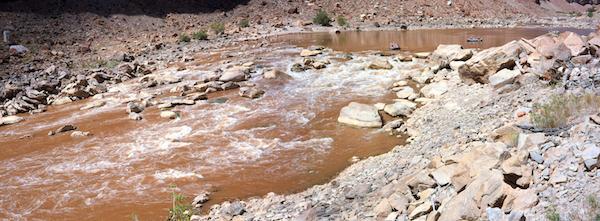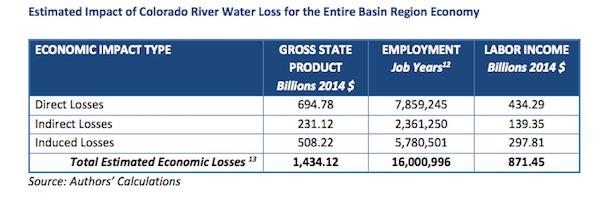
The summer of 2002 brought record low flows to the Colorado River. This shot of the Big Drop Three rapid in Cataract Canyon in Canyonlands National Park at a flow of 2,700 cubic feet shows how recreation can be impacted by a declining Colorado River. Now Arizona State University economists have put a dollar figure on how a drying up of the river would impact the economies of surrounding states/NPS, Neal Herbert
The prospect of the Colorado River running dry anytime soon is hard to fathom. But if it ever does, it will have a devastating effect on the economies of the seven states that rely on the river's life-giving waters, according to a study prepared by Arizona State University researchers.
"Without the full availability of Colorado River water at current levels, the combined economy of the Basin Region is estimated to fall by over $1.4 trillion," the study's executive summary states. The loss would extend to more than 16 million jobs -- with $800 billion in wages -- in the states of Wyoming, Colorado, Utah, Arizona, New Mexico, Nevada, and southern California, it adds.
Put another way, the jobs tied to the river that would be lost are equal to 12.2 percent of national private employment.
Since the mid-20th century, intensive water consumption has dried the lower 100 miles of the Colorado River such that it no longer reaches the sea except in years of heavy run-off; and the United States Bureau of Reclamation (USBR) anticipates significant shortfalls between projected water supplies and demands in the Colorado River Basin in the coming decades.
"We've long suspected the impact of the Colorado River to be quite large, but the results of this study help to quantify it,' said ASU economics professor Timothy James, lead author of the study. 'The detailed analysis reveals how deeply intertwined the economy of the region is with the river's health."
Worries about the Colorado River's flows and the many demands on it are not new, but stretch back decades, and even more than a century if you consider Major John Wesley Powell's admonition that there simply wasn't enough water to go around in the West. The writer Marc Reisner reiterated the message a bit more vehemently in Cadillac Desert, the American West and its Disappearing Water.
More recently, in 2010, Jonathan Waterman, author of Where Mountains are Nameless, Arctic Crossing, Kayaking the Vermilion Sea, and In the Shadow of Denali, took his best shot to convince local, state, and federal officials -- and all the souls who live from Colorado and Wyoming to southern California -- that there is no possible way the Colorado River can survive, let alone sustain, the demands being made on it.
In Running Dry, A Journey From Source to Sea Down the Colorado River, Mr. Waterman cast the Colorado as a diseased coronary artery running through the Southwest. He clearly diagnosed the disease by analyzing the math attached to the water that feeds the various watersheds draining into the Colorado, and the over-appropriated demands on them. He talked with the director of the Glen Canyon Dam that reins in the Colorado before it can sweep tumultuously through Grand Canyon National Park, and in doing so contrasted the ongoing stand-off between hydro-generation and the natural ebb and flow of river flows the canyon needs to stay healthy.
The nine units of the National Park System that help define the river basin -- Rocky Mountain, Black Canyon of the Gunnison, Curecanti, Arches, Canyonlands, Dinosaur, Glen Canyon, Lake Mead, and Grand Canyon -- have been sculpted through time by the currents of the Colorado River and its tributaries.
Today, while the drainage's slacking waters might not outwardly impact the appearance of these parks, they impact them just the same. Fisheries suffer from reduced currents and dropping reservoirs. River runners see the Green, Yampa, and Colorado rivers changed by the lower flows. Vegetation and wildlife in the parks that rely on the rivers are impacted.
The very force that has created these national parks and which in many cases defines many of them is substantially at risk. The growing recreational uses, as a consequence are at risk as well.
Now the economics of the river have come to the forefront in The Economic Importance Of The Colorado River To The Basin Region. Authored by Professor James, Dr. Anthony Evans, Eva Madly, and Cary Kelly at Arizona State's L William Seidman Research Institute, W. P. Carey School of Business, the study works to drive home how a drying up of the Colorado River, for practical purposes, would cripple the surrounding states.
* Economy of the West Crucially Dependent on the Colorado River: Nearly 2/3rds of the CO River Basin's Economic Value Vanishes if the Colorado River Runs Dry
* $871 billion in labor income could be lost EACH YEAR if Colorado River water was no longer available to businesses, industry and agriculture.
* All business sectors risk economic losses if we further deplete this resource. The five PRIVATE SECTOR industries basin-wide that would decline the most are:
--Real Estate & Rental ($174.3 billion)
--Healthcare & Social Services ($148.6 billion)
--Finance & Insurance ($137.1 billion)
--Professional, Scientific & Technical Services ($130.6 billion)
--Retail Trade ($96.2 billion)
If there was just a 10 percent drop in the Colorado River's flow, it would cost the seven states $143.4 billion in lost Gross State Product, the authors estimated, 1.6 million jobs, and $87.1 billion in salaries. A 50 percent decline would chop $717.1 billion from GSP, 8 million jobs, and $435.7 in income, they added.




Comments
I would suggest the people to be impacted decide on what (and who) decide. Politicians have quite a different agenda than who deals with the consequences. They will be gone with their golden parachutes supporting them into the far future (and their heirs). Has anyone noticed the increase in the 1% ownership of all the wealth that exists, under this admin.? The middle class is going down friends.
I do apologize if I've gotten to deep on the subject (as opposed to shallow:).
May surprise you Lee but this is one place I agree that government (state and local) has failed. You won't find a stronger advocate of property rights, but municipalities allowing or even encouraging development that stretches beyond the water resources, available now or into the future, is pure malfeasance. And people who buy these properties without understanding the water implications are just plain stupid.
What makes it worse is that they (governments and people) complain after the fact and want to take from those that planned well to make up for their own shortfalls.
And just think. We might have had two MORE dams on the Colorado River in Grand Canyon. Then David Brower defied the president, Lyndon Johnson at the time. As for "blaming" the president, that is exactly who to blame, starting with Hoover and FDR. They saw these mega dams as make-work projects and thought little of the environment.
Although a different technology, it is much the same with President Obama today. How much do wind and solar power do to SOLVE the problem of climate change rather than simply add to the excuse for growth? Old argument: Stop the floods! New argument: Stop climate change! Old argument: We must flood the canyons to save them. New argument: We must cover the deserts with renewable energy to save them. Save them from what? They got along just fine until too many people came along, but THAT point we ignore.
I prefer not to ignore it, but then, I believe that population is still the problem. EC is right. Why should I pay for everyone else's frivolity? As for moving to Seattle for OUR water, forget it. We are having a low snowpack, too. But yes, feel free to visit, since our tax structure, like so many others, is built on the idea that tourists grow the economy so WE don't have to pay.
Oh Mamma Mia! I agree with EC! And he agrees with me!
This is truly an historic moment!
Well, I don't know if I would go THAT far!
You think Seatle has that mentality. You should come to Breckenridge - or probably any other resort town. The lifty can come here for 22 days and vote himself subsidized housing and child care and millions to "save the plant: and leave at the end of the season. Who pays - the tourist, the condo investor and the second home owner, all of which account for that lifty's job but none of which can vote.
[political conclusion excluded]